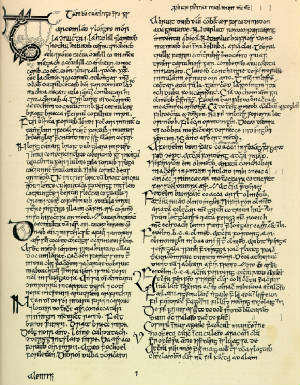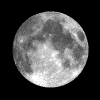|
|
 |
|
'The evidence for the druids as a powerful group of religious leaders is mainly
contained within the comments of Classical writers on the Gaulish Celts. The most famous material is chronicled in writings
of Strabo {IV, 4,4}, Diodorus Siculus {V, 31,2-5) and Caesar (de Bello Gallico VI, 13-14), but all these writers derive their material from a lost shared source,
Posidonius.'
- Miranda J. Green - Dictionary of Celtic Myth &
Legend - P. 86
|
 |
|
Page from the twelfth century Irish
Leabhar na h - Uidhre (the Book
of the Dun Cow), which contains
(the Cattle Raid of Cooley). The
tale consists of the mythical
account of the conflict between
Ulster and Connacht. The most
famous Druid described in the
Táin is Cathbadh, who belonged
to the royal court of King
Conchoba of Ulster.

|
Classical commentators writing about the Celts during the first century BC and the first few centuries
AD, initially mention the Druids as prominent members of Celtic society. They are discussed by several writers, some
of whom - such as Caesar (Gallic Wars), Strabo (Geography) and Pliny (Natural History) - speak at great length about the various functions of the Druids, while others make only brief
allusions to them.
The second body of primary literary evidence concerning the Druids is contained in the myths of Wales and Ireland. These
were written in the vernacular (that is, in Welsh or Irish, rather than in Latin) during the medieval period. The Ulster Cycle
of prose, compiled some time between the seventh and twelfth centuries AD, but probably deriving from much earlier oral tradition,
contains what are arguably the earliest vernacular mythic texts.
One of the most prominent characters in these tales is the Druid Cathbadh, who was attached to the court of King Conchobar
of Ulster. Another group of texts, known as the Mythological Cycle, compiled in the twelfth century, describes a divine race
of Ireland, the Tuatha Dé Danann, who were steeped in Druidic lore and magic. In a different set of stories, the Fenian Cycle, also written down in the twelfth
century, the central character is Finn, leader of the Fianna, a war-band sworn to guard the king. As a child, Finn was reared
by two holy foster-mothers, one described as a ' wise woman ', the other a Druidess. Finally, the early chronicles of Saint
Brigit allude to the rearing of the great sixth-century Irish saint in a Druid's household; and chronicles of Saint Patrick
refer to his encounters with Druids.
|
|
 |
|
|
|
 |
|
|
References to the Druids in the early Welsh literature are more scarce. However there is an interesting parallel to the
Life of Saint Brigit in the twelfth century Life of Saint Beuno, the sixth century canonised abbot, which
contains an account of his death: on his arrival at the gates od Heaven, he encountered Saint Peter, the other apostles and
the Druids.
Only literary evidence, whether from the Classical world or from the vernacular mythic tradition, can give us direct
evidence of the Druids. These documents alone mention them by name: we have no inscriptions or ay images which can certainly
be identified as Druidic. Thus any attempt to use archaeological material as evidence for the Druids must be made with an
awareness that we are dealing with supposition rather than fact.. Perhaps the most important archaeological document which
can be quite firmly linked with the Druids is the Coligny calendar, an incomplete bronze sheet, dating to the first century AD, inscribed in Gaulish with a list of auspicious and inauspicious
days. This was clearly a religious text which priests may have consulted when making their predictions Other archaeolgical material relates not specifically to the Druids but to priests or cult officials in general. There
is evidence of their presence in sacred structures, sacrificial deposits and regalia such as headdress, badges of office and
sceptres. Certain images in stone and bronze may represent clergy rather than the gods themselves, but in the absence of accompanying
dedications, we cannot be sure.
|
![druids in discussion [click for larger image]](sitebuildercontent/sitebuilderpictures/.pond/group-of-arch-druids-and-druids.jpg.w300h362.jpg)
Group with Arch-Druid and Druids
note the toga-like robes, a popular image
|
 |
|
|
|
|
|
|
THE MEANING OF 'DRUID'
It is often thought the the word 'Druid' comes from the Indo-European word 'dru'
for oak. Indeed, in his Natural History, written in the first century AD, the Roman writer, Pliny the Elder makes this connection. But many scholars now believe that the word 'Druid' means 'wisdom'. Even if this is so, however, the
link between 'Druid' and 'oak ' may have been made by the ancient Celts and the Romans because of the recognised association
between the Druids and their sacred tree (right)
|
![druid and oak tree [click for larger image]](sitebuildercontent/sitebuilderpictures/front.jpg)
|
|
|
|
 |

